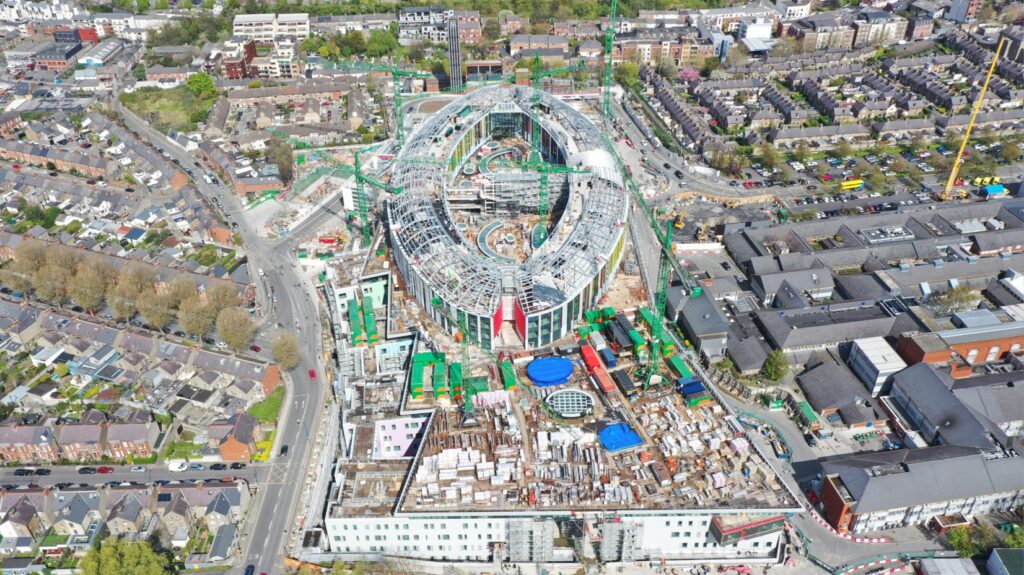6
Context.
National
Context

While pockets of innovation activity exist in several acute hospitals in Ireland, and universities affiliated with hospitals can provide considerable expertise and support in the area of technology transfer, formal supports for innovation practice within hospitals are uncommon. In particular, we are not aware of any well-developed innovation infrastructures in acute hospitals in Ireland. Interest in the concept of healthcare innovation in Ireland would seem to be increasing as evidenced by the number of funding opportunities for innovation projects and the celebration of innovation through awards and recognition.
A number of national initiatives seek to support innovation in healthcare in Ireland including Health Innovation Hub Ireland (HIHI) and the Spark Programme. HIHI was established by the Department of Business, Enterprise and Innovation and the Department of Health, supported by Enterprise Ireland (EI) and the Health Service Executive (HSE) to drive collaboration between the health service and enterprise. It has 3 locations at Cork, Dublin and Galway but provides supports to all HSE services. HIHI seeks to facilitate access for industry partners to clinical sites and for clinicians with innovative ideas to industry partners. The HSE Spark Programme, initially established in 2017 by the National Doctors in Training Programme (NDTP) to support innovation among non-consultant hospital doctors was recently expanded to include nursing, health and social care professionals (HSCPs) and other healthcare staff. As well as providing a range of information and supports, Spark provides several funding opportunities for health service innovations including the HIHI Spark Ignite programme which also provides access to innovation skills through remote and in person workshops.
Although these various programmes offer useful supports for both industry and individuals with ideas for healthcare solutions, the nature of the supports, being independent of the healthcare organisation delivering the care, raises challenges in terms of buy in and implementation. Considerable opportunity exists at an organisational level to put in place structures to support widespread adoption of innovation practice, ensuring consistency with organisational strategy and policy and taking advantage of external opportunities for collaboration and funding.

Context for
CHI
The structures around provision of healthcare services to children in Ireland are undergoing significant changes. The model of care for paediatrics, published in 2016, outlines a national integrated model with acute services for children delivered across a network centred around the new children’s hospital. Implementation of this model is ongoing. The new hospital will amalgamate and streamline all services provided by the three existing children’s hospitals, and will be supported by two ambulatory and urgent care centres at Connolly (opened 2019) and Tallaght (opened 2021). The new hospital will be fully digital, the first such hospital in Ireland. The access to new fully digital facilities and amalgamation of services will provide many opportunities to rethink the way healthcare services are designed and delivered. As we move to this new chapter in healthcare delivery across CHI, having a clear understanding across the organisation about the pace of innovation in healthcare and clearly accessible, well-defined structures around innovation practice will be vital.
The academic environment around children’s health in CHI is evolving considerably. With three hospitals, four partner universities and the National Children’s Research Centre (NCRC), an independent research centre funded by the CHI’s fundraising partner Children’s Health Foundation (CHF), a complex set of relationships existed prior to the establishment of CHI. This is evolving considerably with the formation of the Paediatric Academic Health Science Centre (PAHSC), a formal arrangement between CHI and its four Dublin University partners DCU, RCSI, TCD and UCD. The PAHSC will govern all paediatric education, research and innovation across CHI and the university partners, seeking to integrate research, innovation and training with clinical care and considerably advance the collective quality and impact of this integrated activity. Subject to Government approval, the NCRC will be incorporated into CHI, under the governance of the PAHSC, further consolidating the depth and integration of research and innovation infrastructures within CHI and the PAHSC. This strong and consolidated academic environment is an ideal foundation on which to build a new vision for innovation in children’s health.
One of the core values of CHI is progressiveness. Rather than standing still or merely following the lead of others, we want to continuously learn, improve and develop so that we can provide the best possible care to children across Ireland. This value of progressiveness has been one of the drivers of activity at board and executive levels that has led to the establishment of the current innovation structures in CHI. Innovation practice in CHI in turn has the potential to be a key future driver of the culture of progressiveness across the organisation.
While CHI is the tertiary children’s hospital for Ireland, we are relatively small on an international scale in comparison to some of the leading children’s hospitals, who operate at a volume and scale that we never will. This raises two important points that will be vital in ensuring success for us in the future. Firstly, as is the case in so many realms of Irish society given our status as a small island, we need to be acutely aware of the importance of strong international partnerships and building relationships. This will allow us to access important opportunities and continually develop our offering. Secondly, one of the advantages of being smaller is having the capacity to maintain a strong culture and closely support the implementation of important initiatives. An example of this is the focus on empathy in innovation – the centrality of ensuring that the user’s voice is at the heart of all innovation. In this context, empathy has a strong association with design principles, in particular, design for human use. In ensuring this, and other important basic principles across research and innovation, we can ensure that the quality and relevance of our practice is of the highest international standards, and in doing so ensure that the outputs are translated into meaningful improvements in the care that we deliver to the children of Ireland. We must be practical, honest and brave in the way we approach innovation to ensure that, rather than engaging in activity that on the surface might seem exciting and novel but is ultimately disconnected from meaningful benefit to children and families, we support only initiatives and approaches that have children and families at the heart of them. A singular focus on quality, relevance and impact is what has the potential to set us apart from other centres and make the greatest difference for Irish children.
This is our first Innovation strategy for CHI. The structures across CHI and with our university partners that will underpin the wider paediatric academic environment (including research and innovation) are currently being established. Through funding from the Children’s Hospital Programme, work has already begun in CHI to put basic innovation structures in place to contribute to the integration and rethinking of services across CHI as part of the move to the new hospital, and to plan for the future. Prior to the last year, no formal structures or processes existed in CHI in relation to innovation. This foundation strategy outlines how, from this position, we aim to establish the culture, partnerships and structures necessary to develop a thriving and impactful innovation environment for CHI.

